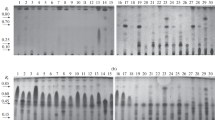Abstract
Cellulase production by fungi was much increased by growing the organisms in media containing small amounts of phenethyl alcohol or other specific organic substances. The concentration of organic added, the culture growth conditions and the type of organism employed were critical factors. These chemicals disrupt a cell function related to cellulase synthesis probably situated in the cytoplasmic membrane. The membrane region of the cell is also considered to be the probable site of cellulase synthesis.
Similar content being viewed by others
References
Berrah, G. & W. A. Kontezka. 1962. Selective and reversible inhibition of the synthesis of bacterial deoxyribonucleic acid by phenethyl alcohol. J. Bact. 83: 738–741.
Dick, C. M. & S. A. Hutchinson. 1966. Biological activity of volatile fungal metabolites. Nature (London) 211: 868.
Glen, A. T. & S. A. Hutchinson. 1969. Some biological effects of volatile metabolites from cultures of Saccharomyces cerevisiae Meyen ex Hansen. J. Gen. Microbiol. 55: 19–27.
Gottlieb. D. & P. D. Shaw. 1970. Mechanism of action of antifungal antibiotics. An. Rev. Phytopath. 8: 371–402.
Hulme, M. A. & D. W. Stranks. 1970. Induction and the regulation of production of cellulase by fungi. Nature (London) 226: 469–470.
Hulme, M. A. & D. W. Stranks. 1971. Regulation of cellulase production by Myrothecium verrucaria grown on non-cellulosic substrates. J. Gen. Microbiol. 69: 145–155.
Lark, K. G. & C. Lark. 1966. Regulation of chromosome replication in Escherichia coli: a comparison of the effects of phenethyl alcohol treatment with those of amino acid starvation. J. Mol. Biol. 20: 9–19.
Lester, G. 1965. Inhibition of growth, synthesis, and permeability in Neurospora crassa by phenethyl alcohol. J. Bact. 90: 29–37.
Nose. M. & K. Arima. 1969. Mode of action of an antifungal antibiotic, pyrrolnitrin. J. Antibiot. Tokyo 22: 135–143.
Nunn, W. D. & B. E. Tropp. 1972. Effects of phenethyl alcohol on phospholipid metabolism in Escherichia coli. J. Bact. 109: 162–168.
Rosenkranz, H. S., H. S. Carr & R. M. Rose. 1965. Phenethyl alcohol. 1. Effect on macromolecular synthesis of Escherichia coli. J. Bact. 89: 1354–1369.
Silver, S. & L. Wendt. 1967. Mechanism of action of phenethyl alcohol: breakdown of the cellular permeability barrier. J. Bact. 93: 560–566.
Treick, R. W. & W. A. Konetzka. 1964. Physiological state of Escherichia coli and the inhibition of deoxyribonucleic acid synthesis by phenethyl alcohol. J. Bact. 88: 1580–1584.
Wood, T. M. 1968. Cellulolytic enzyme system of Trichoderma koningii. Separation of components attacking native cotton. Biochem. J. 109: 217–227.
Author information
Authors and Affiliations
Rights and permissions
About this article
Cite this article
Stranks, D.W., Bieniada, J. Effect of phenethyl alcohol and other organic substances on cellulase production. Mycopathologia 55, 57–63 (1975). https://doi.org/10.1007/BF00467093
Accepted:
Issue Date:
DOI: https://doi.org/10.1007/BF00467093




